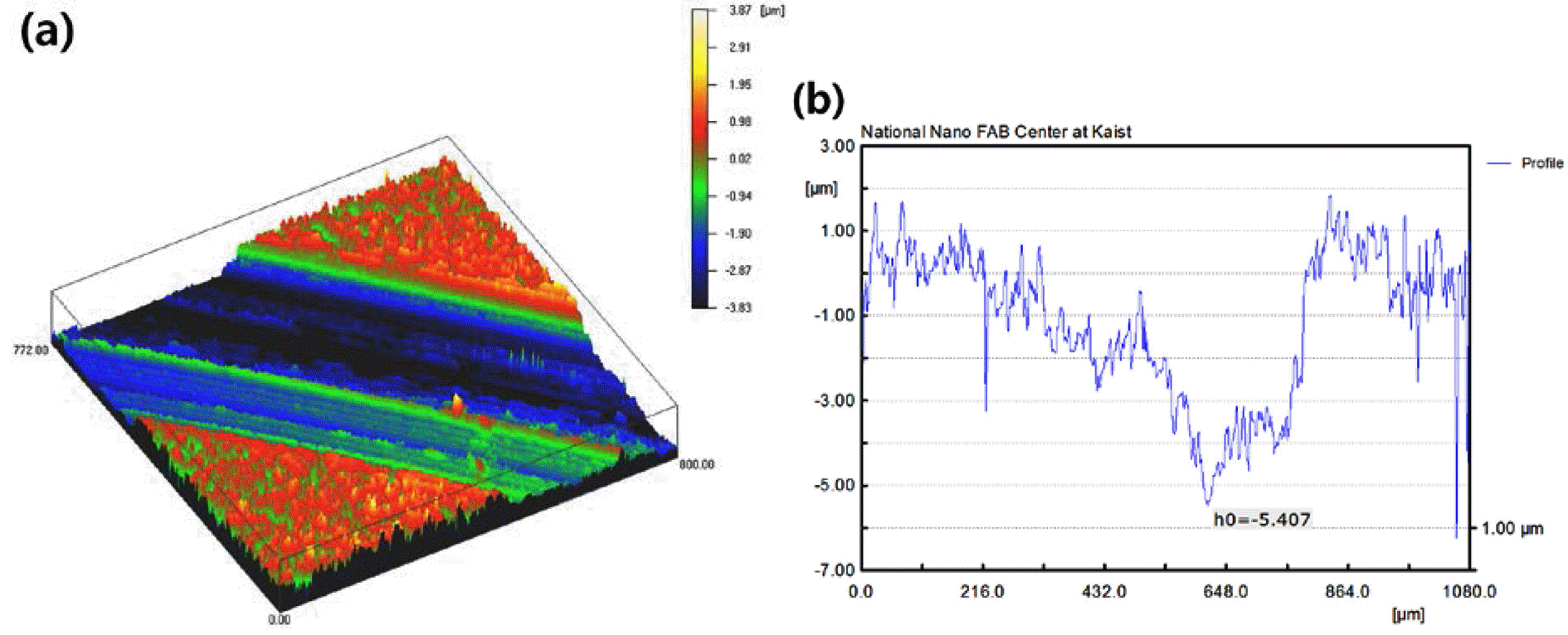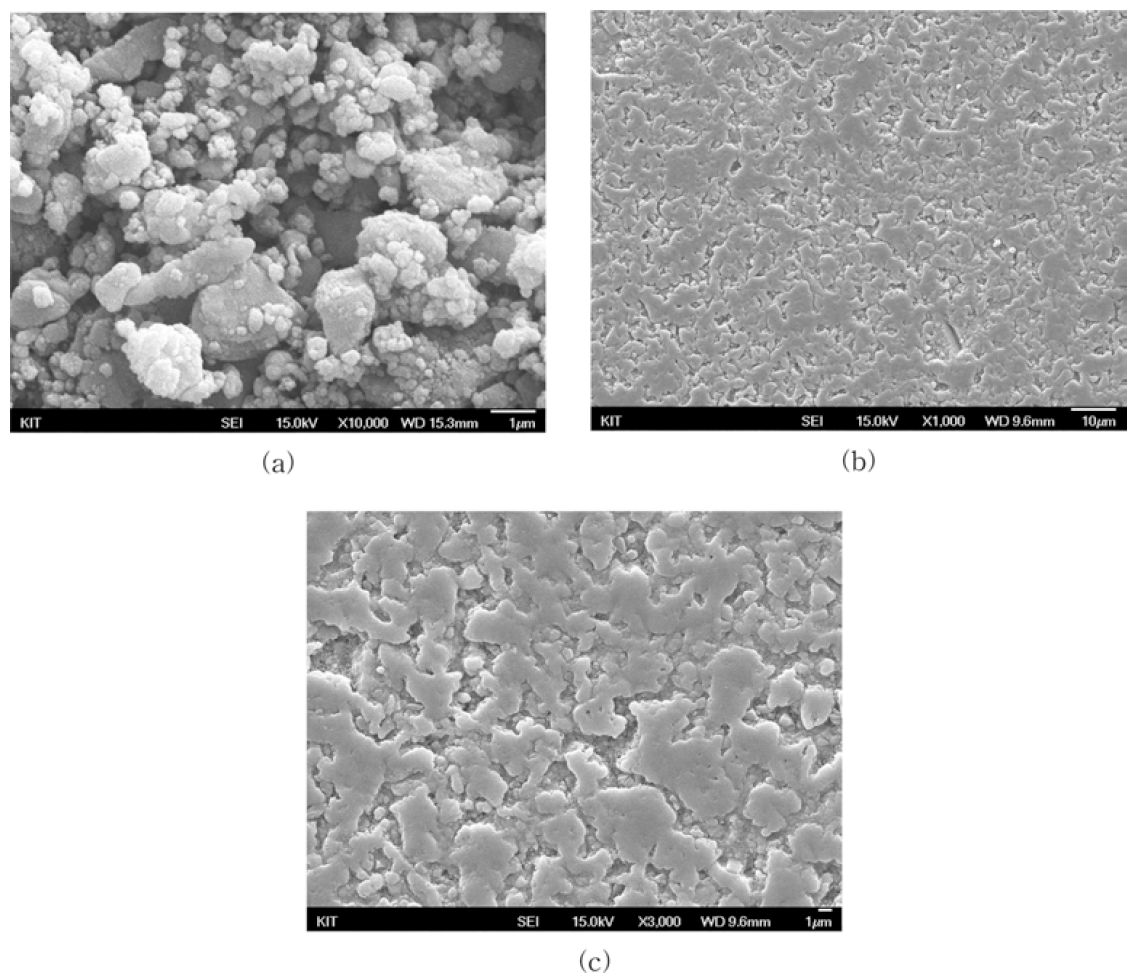Search
- Page Path
- HOME > Search
- [Korean]
- Fabrication and Characterisitics of Al2O3-SiC Ceramic Composites for Electrostatic Discharge Safe Components
- Ha-Neul Kim, Hyun-Myung Oh, Young-Jo Park, Jae-Woong Ko, Hyun-Kwuon Lee
- J Korean Powder Metall Inst. 2018;25(2):144-150. Published online April 1, 2018
- DOI: https://doi.org/10.4150/KPMI.2018.25.2.144

- 424 View
- 4 Download
-
 Abstract
Abstract
 PDF
PDF Al2O3-SiC ceramic composites are produced using pressureless sintering, and their plasma resistance, electrical resistance, and mechanical properties are evaluated to confirm their applicability as electrostatic-discharge-safe components for semiconductor devices. Through the addition of Mg and Y nitrate sintering aids, it is confirmed that even if SiC content exceeded 10%, complete densification is possible by pressureless sintering. By the uniform distribution of SiC, the total grain growth is suppressed to about 1 μm; thus an Al2O3-SiC sintered body with a high strength over 600 MPa is obtained. The optimum amount of SiC to satisfy all the desired properties of electrostaticdischarge-safe ceramic components is obtained by finding the correlation between the plasma resistance and the electrical resistivity as a function of SiC amount.
- [Korean]
- Consolidation to Bulk Ceramic Bodies from Oyster Shell Powder
- Kyeong-Sik Cho, Hyun-Kwuon Lee, Jae Hong Min
- J Korean Powder Metall Inst. 2016;23(3):221-227. Published online June 1, 2016
- DOI: https://doi.org/10.4150/KPMI.2016.23.3.221

- 1,265 View
- 9 Download
-
 Abstract
Abstract
 PDF
PDF Waste oyster shells create several serious problems; however, only some parts of them are being utilized currently. The ideal solution would be to convert the waste shells into a product that is both environmentally beneficial and economically viable. An experimental study is carried out to investigate the recycling possibilities for oyster shell waste. Bulk ceramic bodies are produced from the oyster shell powder in three sequential processes. First, the shell powder is calcined to form calcium oxide CaO, which is then slaked by a slaking reaction with water to produce calcium hydroxide Ca(OH)2. Then, calcium hydroxide powder is formed by uniaxial pressing. Finally, the calcium hydroxide compact is reconverted to calcium carbonate via a carbonation reaction with carbon dioxide released from the shell powder bed during firing at 550°C. The bulk body obtained from waste oyster shells could be utilized as a marine structural porous material.
- [Korean]
- Influence of α-SiC Seed Addition on Spark Plasma Sintering of β-SiC with Al-B-C: Microstructural Development
- Kyeong-Sik Cho, Hyun-Kwuon Lee, Sang-Woo Lee
- J Korean Powder Metall Inst. 2010;17(1):13-22.
- DOI: https://doi.org/10.4150/KPMI.2010.17.1.013

- 618 View
- 0 Download
- 1 Citations
-
 Abstract
Abstract
 PDF
PDF - The unique features of spark plasma sintering process are the possibilities of a very fast heating rate and a short holding time to obtain fully dense materials. beta-SiC powder with 0, 2, 6, 10 wt% of alpha-SiC particles (seeds) and 4 wt% of Al-B-C (sintering aids) were spark plasma sintered at 1700-1850°C for 10 min. The heating rate, applied pressure and sintering atmosphere were kept at 100°C/min, 40 MPa and a flowing Ar gas (500 CC/min). Microstructural development of SiC as function of seed content and temperature during spark plasma sintering was investigated quantitatively and statistically using image analysis. Quantitative image analyses on the sintered SiC ceramics were conducted on the grain size, aspect ratio and grain size distribution of SiC. The microstructure of SiC sintered up to 1700°C consisted of equiaxed grains. In contrast, the growth of large elongated SiC grains in small matrix grains was shown in sintered bodies at 1750°C and the plate-like grains interlocking microstructure had been developed by increasing sintering temperature. The introduction of alpha-SiC seeds into beta-SiC accelerated the grain growth of elongated grains during sintering, resulting in the plate-like grains interlocking microstructure. In the alpha-SiC seeds added in beta-SiC, the rate of grain growth decreased with alpha-SiC seed content, however, bulk density and aspect ratio of grains in sintered body increased.
-
Citations
Citations to this article as recorded by- Effect of Sintering Temperature on Microstructure and Mechanical Properties for the Spark Plasma Sintered Titanium from CP-Ti Powders
Kyeong-Sik Cho, In-Beom Song, Min-Hyeok Jang, Ji-Hye Yoon, Myung-Hoon Oh, Jae-Keun Hong, Nho-Kwang Park
Journal of Korean Powder Metallurgy Institute.2010; 17(5): 365. CrossRef
- Effect of Sintering Temperature on Microstructure and Mechanical Properties for the Spark Plasma Sintered Titanium from CP-Ti Powders
- [Korean]
- Thermal Stability of Al-Fe-X Alloy System Prepared by Mechanical Alloying and Spark Plasma Sintering: I. Al-Fe
- Hyun-Kwuon Lee, Sang-Woo Lee, Kyeong-Sik Cho
- J Korean Powder Metall Inst. 2005;12(1):70-78.
- DOI: https://doi.org/10.4150/KPMI.2005.12.1.070

- 727 View
- 0 Download
- 1 Citations
-
 Abstract
Abstract
 PDF
PDF - Mechanical alloying using high-energy ball mill and subsequent spark plasma sintering (SPS) process was applied to understand mechanical alloying processing of Al-Fe alloy system. The thermal stability of mechanically alloyed Al-Fe alloy was intended to be enhanced by SPS process. Various analytical techniques including particle size analysis, density measurement, micro-Vickers hardness test, SEM, TEM, and X-ray diffractometry were adopted to find optimum processing conditions for mechanical alloying and subsequent SPS and to estimate thermal stability of the prepared alloy. It was found from the treatment of mechanically alloyed Al-8wt.%Fe powder mixture that needle-shaped Al_3Fe precipitates was formed in the Al-Fe matrix, and the alloy compact showed enhanced densification and reached its full density with little loss of its fine microstructure. After heat treatment at 500circC, it was also shown that the thermal stability of Al-8wt.%Fe alloy fabricated in the present study was enhanced, which was due to its fine microstructure developed by fast densification of SPS.
-
Citations
Citations to this article as recorded by- Effect of Sintering Temperature on Microstructure and Mechanical Properties for the Spark Plasma Sintered Titanium from CP-Ti Powders
Kyeong-Sik Cho, In-Beom Song, Min-Hyeok Jang, Ji-Hye Yoon, Myung-Hoon Oh, Jae-Keun Hong, Nho-Kwang Park
Journal of Korean Powder Metallurgy Institute.2010; 17(5): 365. CrossRef
- Effect of Sintering Temperature on Microstructure and Mechanical Properties for the Spark Plasma Sintered Titanium from CP-Ti Powders
- [Korean]
- Thermal Stability of Al-Fe-X Alloy System Prepared by Mechanical Alloying and Spark Plasma Sintering: II. Al-Fe-Cr and Al-Fe-Mo
- Hyun-Kwuon Lee, Sang-Woo Lee, Kyeong-Sik Cho
- J Korean Powder Metall Inst. 2005;12(1):43-50.
- DOI: https://doi.org/10.4150/KPMI.2005.12.1.043

- 657 View
- 1 Download
- 1 Citations
-
 Abstract
Abstract
 PDF
PDF - Mechanical alloying using high-energy ball mill and subsequent spark plasma sintering (SPS) process was applied to Al-Fe-Cr and Al-Fe-Mo powder mixture to investigate effects of Cr and Mo addition on thermal stability of Al-Fe, and thereby to enhance its thermal stability up to 500circC. Various analytical techniques including micro-Vickers hardness test, SEM, TEM, X-ray diffractometry and corrosion test were carried out. It was found that addition of Cr and Mo to Al-Fe system played a role of grain growth inhibitor of matrix Al and some precipitates such as Al_3Fe during SPS and subsequent heat treatment. The inhibition of grain growth resulted in increased Vickers hardness and thermal stability up to 500circC comparing to those of Al-Fe alloy system.
-
Citations
Citations to this article as recorded by- A Constitutional Framework of a Future Palestinian State - Synthesis of Leading Palestinian Thinking and Public Perceptions
Asem Khalil
SSRN Electronic Journal.2009;[Epub] CrossRef
- A Constitutional Framework of a Future Palestinian State - Synthesis of Leading Palestinian Thinking and Public Perceptions
TOP
 KPMI
KPMI


 First
First Prev
Prev


